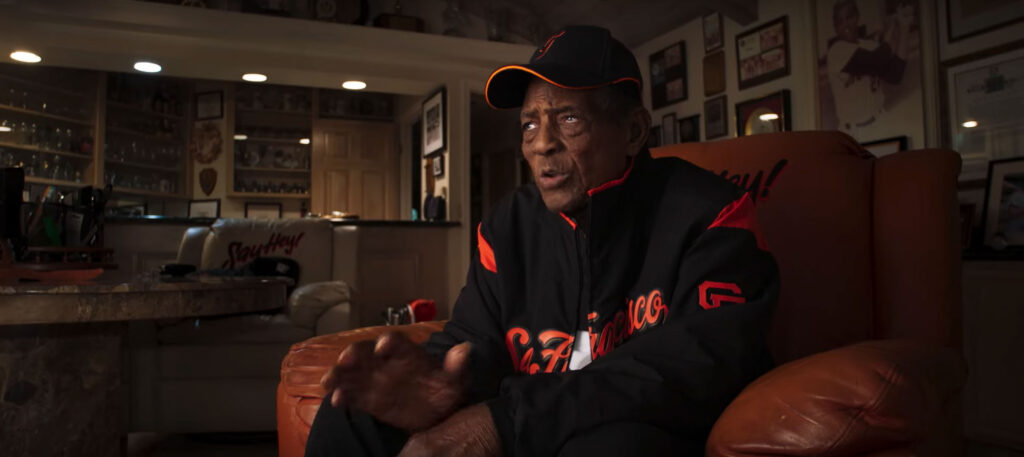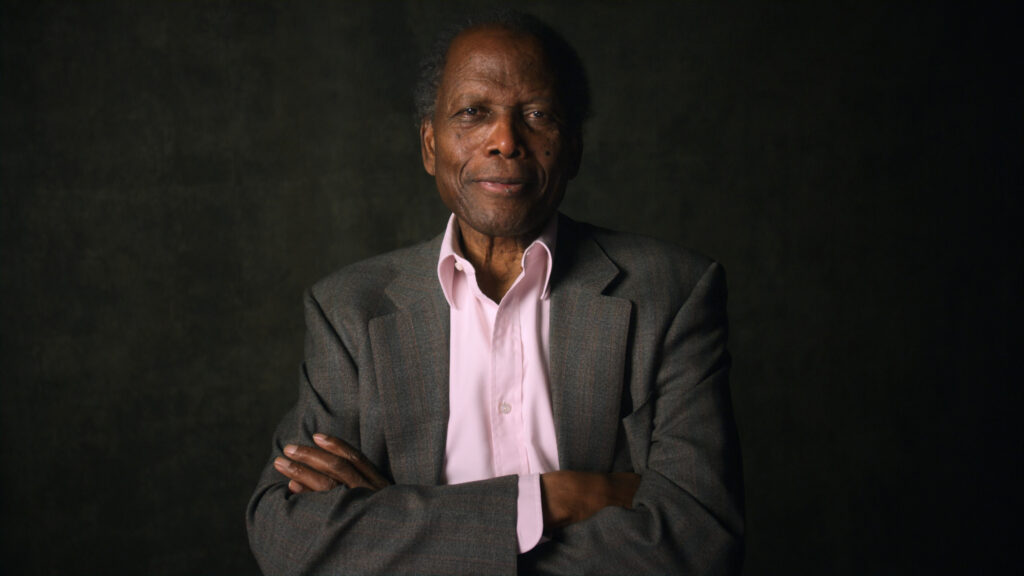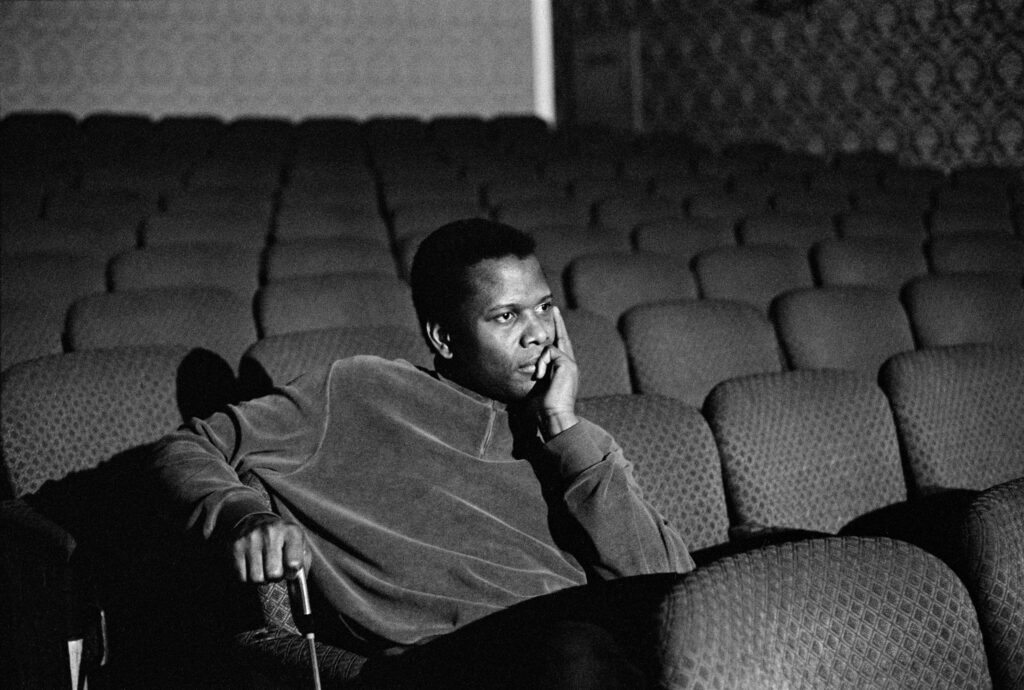January 16, 2023
by Carla Hay


“Say Hey, Willie Mays!” is a laudatory, traditionally made documentary that doesn’t reveal anything new. However, this well-edited movie has a notable lineup of interviewees, including the great Willie Mays himself, who tell very engaging stories. “Say Hey, Willie Mays!” had its world premiere at the 2022 Urbanworld Film Festival in New York City.
Directed by Nelson George, “Say Hey, Willie Mays!” covers many of the same topics that were already covered in the 1988 book “Say Hey: The Autobiography of Willie Mays,” which Mays co-authored with Lou Sahadi. However, the documentary has updates up until the 2020s and has the benefit of being able to tell the story in cinematic form. It’s one thing to read about some of Mays’ iconic baseball games. It’s another thing to see the actual footage.
From the beginning, viewers know that the documentary is going to be a praise fest for Mays. The movie opens with a montage of gushing commentary from star players and experts of American baseball who are interviewed. Baseball star Barry Bonds says, “Willie is always going to be the godfather.” (And, as Bonds describes in detail in teh documentary, Mays literally is his godfather.) Baseball star Reggie Jackson (Mays’ former Oakland A’s rival) comments on Mays: “He is the most spectacular basebally player that ever played.”
Cultural historian Dr. Todd Boyd adds, “He dominated every entirety of the game.” As many baseball fans already know, most star baseball players excel or are known for one or two positions or talents in the game. Mays was extraordinary for excelling at everything in various game positions.
Longtime sports broadcaster Bob Costas credits former New York Giants manager Leo Durocher (who recruited Mays to the New York Giants in 1950, the year thay Mays graduated from high school) with coming up with a term that’s frequently used to describe Mays: “I think he [Durocher] might have been the guy who coined [the phrase] ‘five-tool power.'” The “five-tool player” in baseball refers to a player mastering five key skills in baseball playing: (1) hitting per average; (2) power hitting; (3) running; (4) fielding; and (5) throwing.
Born in 1931 in Westfield, Alabama, May came from humble beginnings and found his baseball calling early in life. He began playing for Birmingham Black Barons of the Negro American League while still in high school.” In the documentary, May reiterates how much Jackie Robinson (the first African American to play in Major League Baseball) had an influence on May: “I was impressed. He could do everything.”
Robinson’s pivotal breaking down of color barriers in Major League Baseball led to the league recruiting of players from the Negro American League, a league that eventually became obsolete as baseball in the United States became racially integrated. Mays was one of those recruited players in the early years of racially integrated Major league Baseball. He endured a lot of racist abuse and discrimination from some people, but most people who were New York Giants fans were thrilled at how Robinson quickly stood out as a player who helped the team win games.
During his early years with the New York Giants, Mays lived in New York City’s Harlem neighborhood, where he said he spent a lot of time at the Red Rooster restaurant/bar. His signature phrase “say hey” came about when he moved to New York, and he would tell people to stop by and “say hey.” Mays shares fond memories of holding court at the Red Rooster as a young man, but viewers will get the sense that he didn’t let all the attention of being a local hero go to his head.
In fact, several times throughout the documentary, it’s mentioned and shown how Mays spent much of his life using his fame and fortune to help others, especially underprivileged young people, including launching the Say Hey Foundation in 2000. “Say Hey, Willie Mays” also addresses the criticism that Mays got (including from his idol Robinson) for not publicly taking more of a political stand during the U.S. civil rights movement and the Black Power movement during the 1960s and 1970s. Mays says that it was never his style to publicly talk about politics, and his way of helping fellow African Americans was through his charitable work that he often did not publicize. Boyd comments, “Willie did things for people behind the scenes.”
After winning the 1954 World Series with the New York Giants (who were the underdogs against the Cleveland Indians), Mays moved to San Francisco when the Giants relocated to San Francisco in 1958. The documentary mentions that at the time, retired baseball star Joe DiMaggio (a San Francisco native) was the biggest baseball star in San Francisco. Mays, who was a big deal in New York, was somewhat overshadowed at first by the celebrity legend of DiMaggio in San Francisco, and had to work hard to win over skeptical fans in the San Francisco area.
But even with all the accolades, fame and money that Mays had because of his baseball career, Mays still experienced harsh racial discrimination. He and his first wife Marghuerite, whom he married in 1952, were not allowed to buy a house in an upscale San Francisco neighborhood populated by white people, not because the couple didn’t have the money but because of their race. The racism involved in Mays not being able to buy this house got a lot of media attention.
After a lot of public uproar, he and Marghuerite eventually bought the house, but many of the neighbors still objected to the couple living there. Mays says in the documentary that the stress of this ordeal contributed to the eventual breakdown of the couple’s marriage. He and Marghuerite separated in 1962 and officially divorced in 1963. Mays wed his second wife Mae (who was a social worker) in 1971, and they were married until her death in 2013, at the age of 74.
While a member of the San Francisco Giants, Mays became the team’s unofficial leader, say several people in the documentary. He also defended the Spanish-speaking Latino players against racism they experienced from people who didn’t want Spanish to be spoken in the team clubhouse. Mays’ former Giants teammates Orlando Cepeda, Ozzie Virgil Sr., Juan Marichal and Tito Fuentes all praise Mays for his leadership skills and for how well he treated people. Cepeda, who was a bat boy for May when Mays visited Puerto Rico, says in the documentary: “The reason why I came to play baseball was because of Willie.”
Even though Mays was eventually traded to the New York Mets in 1972 and made it to the World Series with the Mets in 1973 (the Mets lost, and he retired that year), he will be mostly remembered for his association with the Giants. Former San Francisco Giants star Bonds, who is perhaps the most famous protégé of Mays, speaks at length and sometimes gets emotional when talking about how Mays was more than a mentor to Bonds. Mays was also a second father figure to Bonds, especially after Barry’s father Bobby Bonds (who was a former San Francisco Giants teammate of Mays) passed away in 2003. Barry says, “My dad loved Willie more than anything. Willie took all the black athletes and the time and put them on his shoulders.”
It’s fairly common knowledge among baseball fans that Mays (who received a lifetime contract to work for the San Francisco Giants in 1992) was instrumental in getting the San Francisco Giants to recruit Barry. Barry also says that Mays encouraged Barry to break Mays’ record of having the most home runs in a single season for a National League player. Barry says that Mays told him about breaking Mays’ record: ‘You better pass me, and you better keep going.'” Barry eventually did that and more: In 2001, he broke the Major League Baseball record for having the most home runs (73) in a single season.
However, “Say Hey, Willie Mays” completely ignores that Barry’s career and reputation were tarnished by his “doping” scandal, when it was revealed that he used steroids during his baseball career. If Barry and/or Mays were asked about this scandal for the documentary, it’s not in the movie. It’s also possible that Barry wouldn’t agree to be interviewed if he had been asked about the scandal in this documentary, but that isn’t mentioned in the film either. Viewers can only speculate why such a big “elephant in the room” was not addressed at all in this documentary.
The closes that the documentary that alludes to Barry’s baseball career ending in some kind of disgrace is the documentary’s use of an archival footage clip during a 2018 ceremony of Barry’s number 25 being retired by the Giants. During the ceremony, Willie gives a speech and makes an emotional plea his for Barry to get voted into the Baseball Hall of Fame. Although Barry is eligible, he hasn’t received enough votes to be inducted into the Baseball Hall of Fame, presumably because of the doping scandal.
Other people interviewed in the documentary include historian/activist Dr. Harry Edwards; Faye Davis, daughter of “godfather of black baseball” Piper Davis; Rickwood Field president Gerald Watkins former baseball player Rev. William “Bill” Greason, Willie’s friend/mentor; sports broadcaster Vin Scully; former San Francisco mayor Willie Brown; Dusty Baker, a Major League Baseball player-turned manager; San Francisco Giants president/CEO Larry Baer; and former San Francisco Giants clubhouse senior advisor Miguel “Mike” Murphy, who retired in 2023.
“Say Hey, Willie Mays!” does a credible job of putting into context the racism obstacles that Willie and some of his other non-white teammates experienced and how he used those experiences to help others. Willie Mays’ son Michael Mays, who is interviewed in he documentary, says that any racism that Willie experienced was something he left behind when he played on the field, but off the field it was something he tried to turn from a negative to a positive. Michael adds, “He comes from a family where everybody helps everybody.” Boyd adds of Willie: “He had the power to open the doors for other people.”
However, the documentary doesn’t dig any deeper to find out how Willie’s close faher/son-type relationship with Barry affected Michael or other members of the Mays family. “Say Hey, Willie Mays!” is certainly inspirational, but it doesn’t provide much new insight into Willie except to praise all of his glories without a full exploration of any of his failings and what he might have learned from any mistakes he made in his life. Overall, “Say Hey, Willie Mays!” is not a completely well-rounded or grounbreaking documentary, but it’s a treat to watch for baseball fans or anyone who likes to see biographies of people who have lived their lives with dignity and respect.
HBO premiered “Say Hey, Willie Mays!” on November 8, 2022.


